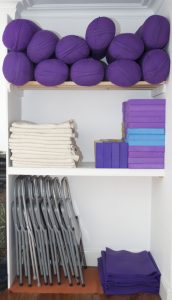I have been really looking forward to observing the medical classes here. I live too far away from a medical class to be able to assist regularly in one, and have had to rely on workshop training. It’s quite a different thing to see the hall full of regular students here at RIMYI, and how they’re helped.
be able to assist regularly in one, and have had to rely on workshop training. It’s quite a different thing to see the hall full of regular students here at RIMYI, and how they’re helped.
Rather than a sequence of poses (everyone has their own programme) or describing the poses (I had no idea what each person’s particular medical problem was, so there’s no way of applying what I observed at this point), here are some general observations.
There were maybe around 20 students in the class, and almost as many teachers and assistants. Some students seemed to be paired up with teachers for the duration of the class (1hr45m); other assistants ‘floated’, offering help where they saw it was needed or when they were asked. It isn’t clear to all assistants what each student’s medical problem is.
It was impressive how each student was familiar with their personal programme. In fact often they seemed to be the experts, and the teachers were the fetcher-carrier-adjusters.
I heard one old fellow near me directing his young assistant: ‘Put this here, that there. Now get two wooden bricks and one foam one. We will need those. And the blanket just here. This is how Geetaji showed me. Now leave it for six minutes and wait for the magic to occur. I have confidence that everything will be alright’. Someone told me that this twinkly-eyed grandpa has leukaemia.
The anecdote above really illustrates for me how the student, the sadhaka, is absolutely at the centre of Iyengar’s work. There is a lot of press about super-star yoga gurus at the moment; not much of it good. What I saw today was students with agency; individuals taking responsibility for their own health, for their own yoga practice. The teachers were firmly cast in the supporting role, which they performed with skill and accuracy.



Comments are closed.